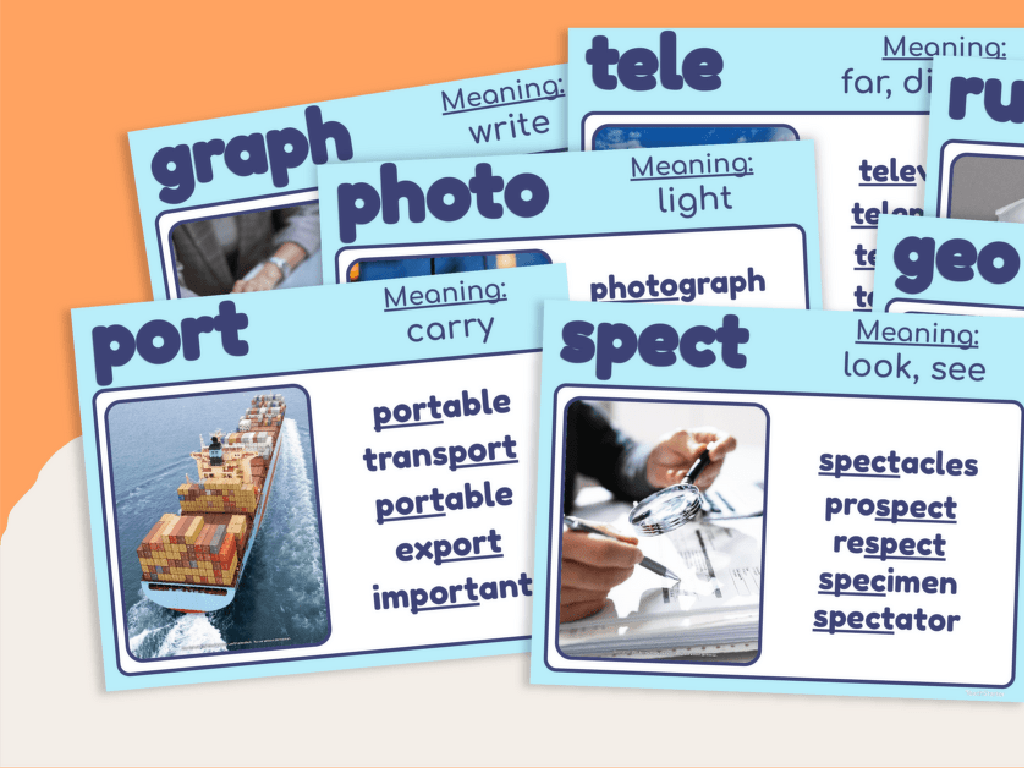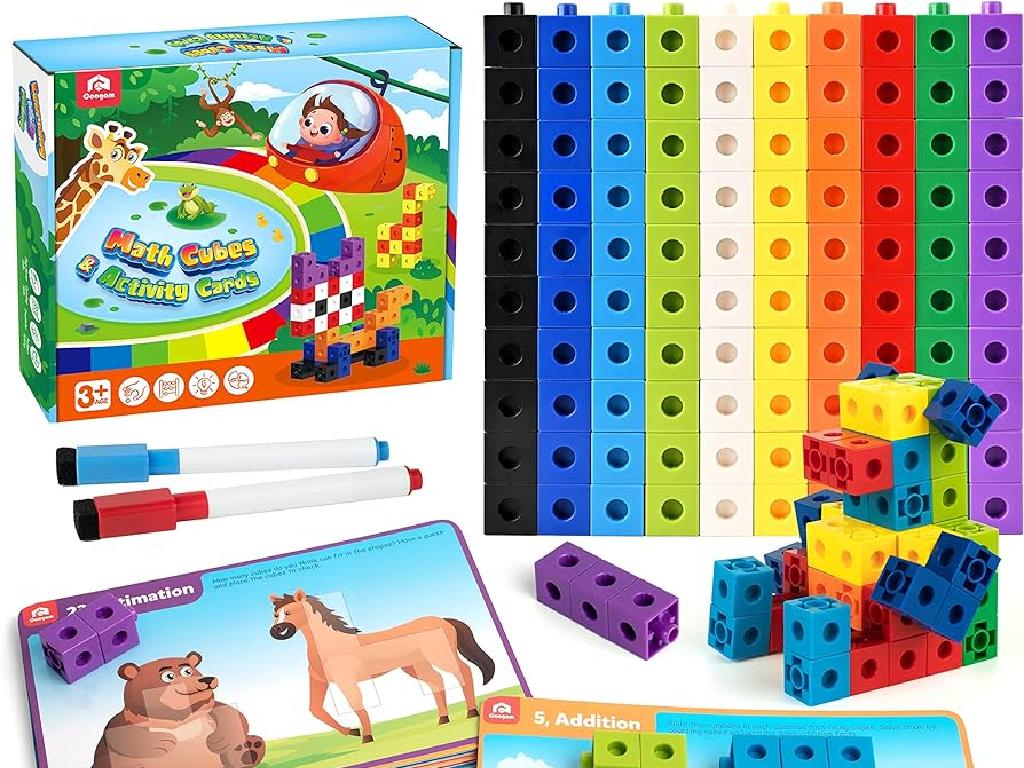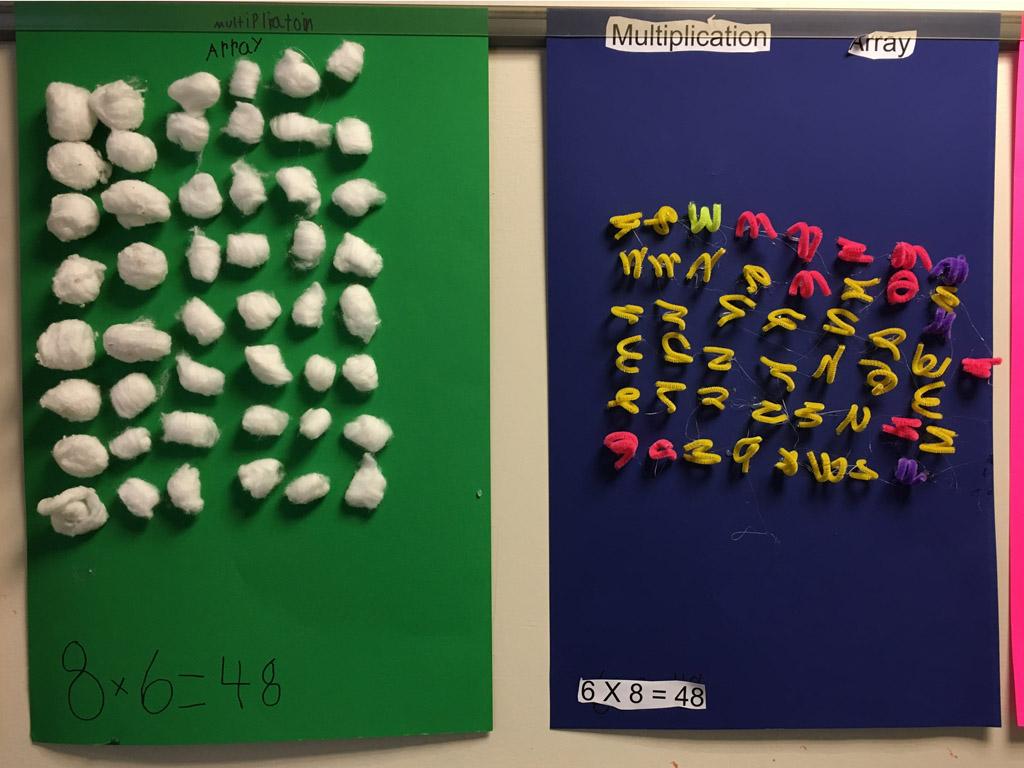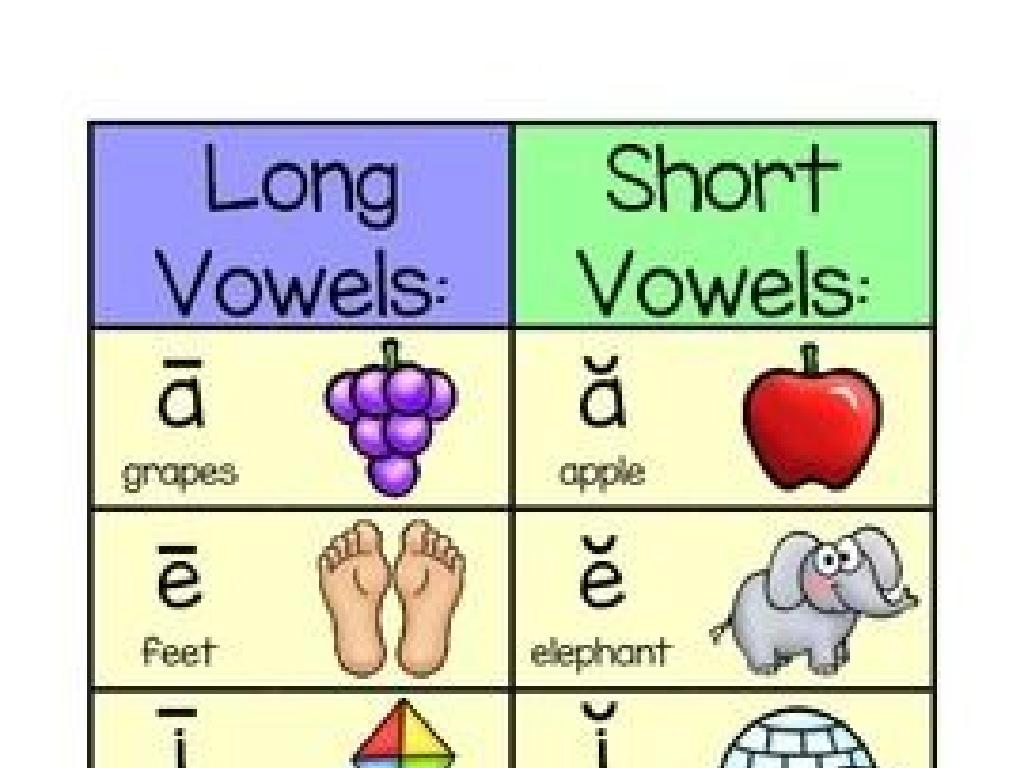Division Facts To 12
Subject: Math
Grade: Fourth grade
Topic: Division
Please LOG IN to download the presentation. Access is available to registered users only.
View More Content
Today’s Adventure: Division Facts to 12!
– What is division?
– Division as equal sharing
– If you have 12 cookies and 4 friends, how do you share?
– Division in daily life
– Used for splitting bills, dividing tasks, or sharing snacks.
– Practice with numbers 1-12
– Let’s solve 12 ÷ 3 or 12 ÷ 4 together!
|
This slide introduces the concept of division to fourth graders, framing it as an adventure to make learning fun. Begin by explaining division as a method of sharing things equally among a certain number of people or groups. Emphasize the practicality of division in everyday scenarios, such as sharing food or dividing up chores, to help students understand its relevance. Encourage students to think of their own examples of division in their lives. Conclude with interactive practice of division facts using numbers 1 through 12, ensuring students grasp the concept of dividing small quantities evenly. This will set a solid foundation for understanding larger division problems in the future.
Understanding Division
– Division: Splitting into equal parts
– Division is opposite of multiplication
– Example: 12 ÷ 3 = 4
– If 3 groups of 4 make 12 in multiplication, then 12 divided into 3 groups gives 4 each
– Practice with numbers up to 12
– Use flashcards to divide objects into groups
|
This slide introduces the concept of division to fourth-grade students. Begin by explaining that division is a way of splitting a number into equal parts, much like sharing equally among friends. Emphasize that division is the reverse process of multiplication, and use simple examples to illustrate this point. For instance, if they know that 3 times 4 equals 12, then dividing 12 by 3 will give them 4. Encourage students to think of division as a fair sharing method. Provide them with hands-on practice by using flashcards and dividing objects into groups, ensuring they understand the concept with numbers up to 12. This foundational understanding will help them with more complex division problems in the future.
Understanding Division Vocabulary
– Dividend: Number being divided
– If you have 12 apples and 4 friends, 12 is the dividend.
– Divisor: Number you divide by
– Using the same example, 4 is the divisor.
– Quotient: Division problem answer
– How many apples does each friend get? That’s the quotient.
– Practice with examples
|
This slide introduces the basic vocabulary of division to help students understand the components of a division problem. The dividend is the total amount you want to divide up, the divisor is the number of groups you are dividing into, and the quotient is the result or how many are in each group after dividing. Use concrete examples like sharing apples among friends to illustrate these concepts. Encourage students to come up with their own examples and to identify the dividend, divisor, and quotient in each. This will help solidify their understanding of division vocabulary and prepare them for solving division problems.
Mastering Division Facts to 12
– Memorization aids quick problem-solving
– Recognize patterns in division facts
– Patterns make it easier to remember facts
– Practice division with 12
– Let’s try: 12 ÷ 1 = 12, 12 ÷ 2 = 6, and so on
– Division by 1 to 12
– Understanding that 12 ÷ number gives a sequence
|
This slide is aimed at helping students understand the importance of memorizing division facts up to 12 to enhance their problem-solving speed. Emphasize the role of recognizing patterns to make memorization easier. For example, dividing by 1 always results in the same number, and dividing by 2 cuts the number in half. Engage the class in practicing these division facts with 12 as the dividend, going from 12 ÷ 1 up to 12 ÷ 12. This exercise will help solidify their understanding of division and prepare them for more complex problems. Encourage students to work through these problems both in class and as homework to build their confidence and proficiency in division.
Using Multiplication to Understand Division
– Multiplication helps with division
– If 4 x 3 equals 12, then 12 ÷ 3 equals 4
– Knowing that 4 groups of 3 make 12 helps us see that 12 divided into 3 groups gives us 4
– Multiplication and division are connected
– Use multiplication facts to divide
– Remembering your times tables can make division easier
|
This slide aims to show students how multiplication and division are inverse operations. Understanding one can help with the other. If students are familiar with multiplication facts, they can use that knowledge to solve division problems. For example, if they know that 4 multiplied by 3 equals 12, they can easily figure out that 12 divided by 3 equals 4. This is because the multiplication fact tells us how many times a number is added to itself to reach a product, and division tells us how many times that product can be divided by one of the factors to get the other factor. Encourage students to practice their multiplication tables as this will greatly aid their ability to solve division problems.
Let’s Practice Division!
– Solve 12 ÷ 4 together
– How many times does 4 fit into 12?
– Now try 12 ÷ 6 on your own
– Use counters or draw a picture if it helps
– Challenge: What’s 12 ÷ 8?
– Think: If I share 12 cookies with 8 friends, how many does each get?
– Check answers with a partner
|
This slide is designed to engage students in practicing division facts up to 12. Start by solving 12 ÷ 4 as a class, guiding them through the process. Encourage students to visualize the division or use manipulatives. Then, have them try 12 ÷ 6 independently, offering support as needed. Introduce 12 ÷ 8 as a more challenging problem and encourage them to use problem-solving strategies. Finally, pair students up to check their answers, fostering peer learning. This activity reinforces division skills and promotes collaborative learning. Be ready to assist and clarify any misconceptions.
Word Problems with Division
– Applying division in real life
– Use division to share or group items equally.
– Steps to tackle a division problem
– 1. Read carefully. 2. Visualize with a drawing. 3. Write the division equation.
– Let’s solve a problem together!
– Example: 12 cookies shared by 4 friends. How many cookies does each get?
|
This slide aims to help students understand how division is used in everyday situations. Start by explaining that division can be used to share things equally or to figure out how many groups of a certain number we can make. Walk them through the process of solving a word problem: reading the problem thoroughly, drawing a picture to represent the problem, and then writing the corresponding division sentence. Solve an example problem as a class, such as dividing a set number of items among a group of people, to demonstrate the process. Encourage students to visualize the problem to better understand it. This interactive approach helps solidify their understanding of division in a practical context.
Division Games: Making Math Fun!
– Division can be exciting with games
– Let’s play ‘Division Bingo’ together
– A game where each number on your card can be marked by solving division problems
– Correct answers move you towards Bingo
– Get five correct answers in a row to win
– Enjoy learning with classmates
|
This slide introduces ‘Division Bingo’, a fun and interactive way to help students practice their division facts up to 12. The game is played similarly to traditional Bingo, but instead of numbers being called out, division problems are presented. When a student solves a problem correctly, they can mark the corresponding number on their Bingo card. The first student to get five correct answers in a row, column, or diagonal wins the game. This activity encourages participation, reinforces division skills, and provides a competitive element to the learning process. Prepare multiple Bingo cards with answers to division facts up to 12, and ensure to rotate the problems so each student gets a chance to solve different equations. This will cater to varying levels of proficiency within the class.
Division Relay Race
– Understand the relay race rules
– Solve division facts quickly
– Use division facts up to 12 to advance
– Teamwork to reach the finish
– Help each other with tricky problems
– Celebrate our division mastery
|
This class activity is designed to make learning division facts up to 12 fun and interactive through a relay race. Divide the class into small teams. Each team member must solve a division fact to move forward. If a student struggles, they can pass the baton to the next team member, emphasizing teamwork. Set up stations with different division facts, and students race to solve them. Possible variations include a timed challenge, obstacle course with math problems, or a scavenger hunt where each clue solved leads to the next. Celebrate all students’ efforts and mastery of division facts at the end of the activity.
Conclusion & Homework: Mastering Division Facts
– Excellent work on division facts!
– Complete the division worksheet
– Finish the provided worksheet to practice.
– Use multiplication as a tool
– Multiplication is the reverse of division. Use it to check your work!
– Practice leads to perfection
|
As we wrap up today’s lesson on division facts up to 12, it’s important to reinforce the concept through practice. The homework worksheet is designed to help students apply what they’ve learned in class. Encourage them to use multiplication as a strategy to solve division problems, as understanding the relationship between these operations is crucial. Remind them that consistent practice is key to mastering division facts. For the next class, be prepared to review the homework answers and address any difficulties the students may have encountered.





